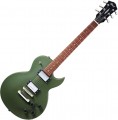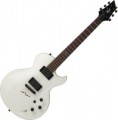Pickups
Type of pickups used in electric guitar.
—
Passive. Passive pickups are called pickups that do not use their own power supply. Such devices produce a weak signal, so guitars with passive pickups require an external preamp. In terms of sound, many musicians consider passive pickups to be more "natural" and dynamic, but this point is largely subjective. The unequivocal advantage of this option is the extensive features for experimenting with the technique of sound extraction. In addition, passive modules are much simpler and cheaper than active modules, and they do not require their own power supplies. On the other hand, these pickups are subject to feedback, which can be problematic in some situations. Yes, and sensitivity to pickups (and, accordingly, the likelihood of interference) they are significantly higher.
—
Active. Pickups supplemented with built-in preamps to increase the level of the signal fed to the output of the instrument. Thanks to the additional amplification, many models have fewer coil turns than passive models, which reduces interference and provides a cleaner and more balanced signal. At the same time, the active module retains the upper frequencies better; this gives the effect of "brightness", "transparency" of the sound. However there is an opinion that this sound turns out to be unnatural, but this moment, again, is largely subjective. But from the unequivocal disad
...vantages of active pickups, one can note the need for their own power source. One of the most popular options for this is a 9V battery, which is installed in a special compartment in the body of the guitar.Tone controls
The number of tone controls provided in the design of an electric guitar.
One tone control is responsible for the sound of the electric guitar as a whole; but if there are several such pens, they can have different formats of work. So, each knob can be responsible either for its own pickup, or for a separate frequency band. In the second case, a set of knobs plays the role of an equalizer that allows you to adjust the sound by changing the volume of low and high (sometimes even separately middle) frequencies.
Anyway, the presence of several tone controls expands the possibilities for changing the coloring of the sound by means of the guitar itself, without the use of additional equipment.
Pickguard
The presence of a protective lining (pickguard) on the body of the guitar.
Such an overlay is located on the upper deck, most often made of durable plastic and differs markedly in colour, due to which it is clearly visible. Its main purpose is to protect the soundboard surface from pick strikes (for example, when playing with dynamic fighting), which could damage the varnished wooden surface. The specific shape and size of the fingerboard may vary, but anyway, it covers at least the surface below the strings (when looking at the guitar in the working position), and sometimes under the strings and even above them.
Through string attachment
The presence in the electric guitar of a system of through fastening of strings.
In the classic through fastening, the body of the instrument itself plays the role of a stop bar — holes are made in it, in which the strings are fixed (from the side of the bridge). The advantage of this design is the improved contact of the strings with the body, which allows you to achieve good sustain. However, in tremolo machines (see "Bridge") there is another kind of through fasteners — when the holes are located not on the body, but on the bridge; in particular, this option is typical for Vintage Tremolo machines. In such cases, the through fastening itself is only a design feature of the bridge, and the contact of the strings with the body depends on the features of the fastening of the "machine" on the body and can be different.
Neck profile
Profile of a fretboard mounted on an electric guitar.
The profile of the neck is called its shape in section, more precisely, the shape of the back of the neck. This parameter practically does not affect the sound of the guitar, but it directly affects the convenience of playing. Ideally, the neck should “fill” the hand, but not be too large — otherwise it will not be possible to clasp it to the right extent.
Profiles are denoted by the letters C, D, V and U — depending on which letter the neck resembles in the section. Profile D is the flattest, C is slightly more convex, with almost uniform curvature along the entire length, U is more voluminous, with a wider profile in the area of the lining, and the V profile in its classic form has the form of an angle with a rounded top. There are also modifications of these options — for example, "thin", which provides for a reduced profile thickness, or "modern", with slightly improved (theoretically) ergonomics.
The most popular profile types are
C,
U and their "modern" (modern) modifications. The C profile is almost semi-circular, the U profile is more voluminous, at the fingerboard its edges are almost parallel and only closer to the back of the neck are sharply rounded. The terms
modern C and
modern U refer to various improved versions of these profiles, their f
...orm may be different.
In fact, the choice of neck profile depends solely on the guitarist's personal preferences, the characteristics of his hands and his preferred playing technique. Thus, there is no "perfect" profile shape — in each case, the optimal choice will be different. The perfect option is to try several types of profile "live", decide which one will be more convenient, and choose an instrument with a neck of the same or similar profile shape.Nut width
The width of the fretboard of an electric guitar at the nut. Closer to the body, the neck may expand somewhat, but this is not necessary, and the expansion angle may be different. Therefore, the main size is considered to be the width in the region of the nut.
This parameter has two meanings. On the one hand, a wide neck is inconvenient for musicians with small hands and short fingers — it can be difficult to reach the far strings in such cases. On the other hand, a larger width means a greater distance between the individual strings, which reduces the likelihood of hitting an adjacent string when pressed incorrectly and can make playing easier (especially if the guitarist has large fat fingers). However, these moments are not absolute, and the convenience of playing is a very subjective matter, depending on many features of the musician and the technique he uses. Also, don't forget that necks can have different profiles (see above), and instruments with different neck profiles will feel differently in the hands even with the same width at the nut. Therefore, the most reliable method of selection is to try out the necks of different sizes and profiles “live”, decide on the best option and choose based on this.
The smallest neck width at the nut in modern electric guitars is about 39 mm. This size is found mainly in bass guitars (see “Type”), which have 4 strings and a neck that widens noticeably towards the body (due to which it can be made rather narr...ow from above, especially since when playing bass, notes are rarely clamped near the neck itself) . Electric guitars (including semi-acoustic) are somewhat wider — from 41 mm, an indicator of 43 – 48 mm is considered average, and in the largest instruments, the neck can be up to 55 mm wide (however, such dimensions are typical mainly for instruments with more than 6 strings) .
Fretboard
The material from which the fretboard of an electric guitar is made.
The fretboard is placed under the strings, where the strings are pressed when played. The need to use overlays is due to the fact that the types of wood from which the fingerboard itself is made are often not hard enough, and dents could occur on their surface from constant contact with the strings. Accordingly, the overlays are made of a harder material that retains the shape of the surface even after repeated pressing of the strings. As such a material, both special types of wood (
ebony,
rosewood) and high-quality phenolic polymers can be used.
In general, the quality of the fingerboard is usually quite consistent with the price category of the instrument, but it hardly makes sense to dwell on the detailed characteristics of each material (they are not so critical for the normal use of an electric guitar). We only note that the material of the overlay directly affects the appearance of the instrument.

